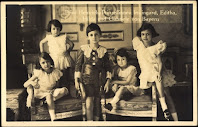Irmingard Princess of Bavaria was a granddaughter of Bavaria’s last king Ludwig III. In 2000, she published her memoirs about her childhood and World War II. She received the Price for World Peace from the Brücke 7 Foundation for her engagement in keeping the memory about the Holocaust alive.
Every year, the family spent the summer in Berchtesgaden until Hitler was made Chancellor of Germany and started spending time at his Berghof Residence in Berchtesgaden. The family henceforth shunned the place and spent the summers in the Royal Castle Hohenschwangau in the Bavarian Alps. Almost immediately after taking power, Hitler confiscated the Royal Bavarian residence Wittelsbach Palace in Munich and turned it into the headquarters for the Gestapo. In 1934, he also confiscated Castle Leutstetten.
In 1936, Irmingard and her sister Editha were sent to a boarding school in Roehampton near London. She joined her Luxembourg cousins there; a year later, two more of her sisters joined her. She later continued her education in Belgium before joining her family in exile in Italy. Her father had refused to vote for Hitler in the Reichstag of 1936; he equally refused to hoist Nazi flags on his remaining Royal Residences. All of which marked him as an enemy of the state (Americans know how that works).
In 1939, King Vittorio Emmanuele of Italy sent his personal train to Munich to collect the Bavarian Royal Family and convey them into exile in Italy. But later in the war, the family was caught behind German battle lines in Italy in 1944. Prince Rupprecht escaped capture by the Gestapo in hiding in Florence while his wife and some of his daughters were apprehended and brought into the concentration camp Sachsenhausen in Berlin.
Irmingard managed to flee from the Gestapo making her way towards Switzerland on foot. She contracted typhoid fever during this flight and was caught by the Gestapo near Lake Garda. She was brought to the military hospital in Innsbruck in Austria where she survived the bombing of the town by allied forces. She was then sent to join her family at Sachsenhausen. When Soviet troops had almost enclosed Berlin, the family was moved to the concentration camp Flossenbürg near Regensburg, and from there to Dachau. There, the family was freed by the Third American Army.
In 1950, Irmingard married her cousin Ludwig Prince of Bavaria at Nymphenburg Palace in Munich. As a prince from a formerly ruling family, Ludwig had been ejected from the German Wehrmacht as a perceived threat to Hitler's power. Ludwig had spent the war in Hungary looking after the Royal Bavarian Stable at Sàrvàr. When Hungary was overrun by Soviet troops, he packed up the retainers, their families, and the horses to make a trek to Germany. He managed the impossible and passed undetected through the Soviet front lines into Bavaria with horses, men, women, and children. He died on October 17, 2008, at Castle Leutstetten.
Irmingard became an active member of foundations aimed at keeping the memory of the Holocaust alive. In 2000, she published her Memoirs of My Youth 1923 – 1950. Her book gives a very realistic and shocking view of the concentration camp Flossenbürg: “We were housed in a separated barrack; every day, dead bodies would be stacked in front of our window like wood.” Unhappily, the book is only available in German.
In 2008, Irmingard received the Price for World Peace from Brücke 7 Foundation in Munich. She died on October 23, 2010, at Castle Leutstetten.








No comments:
Post a Comment